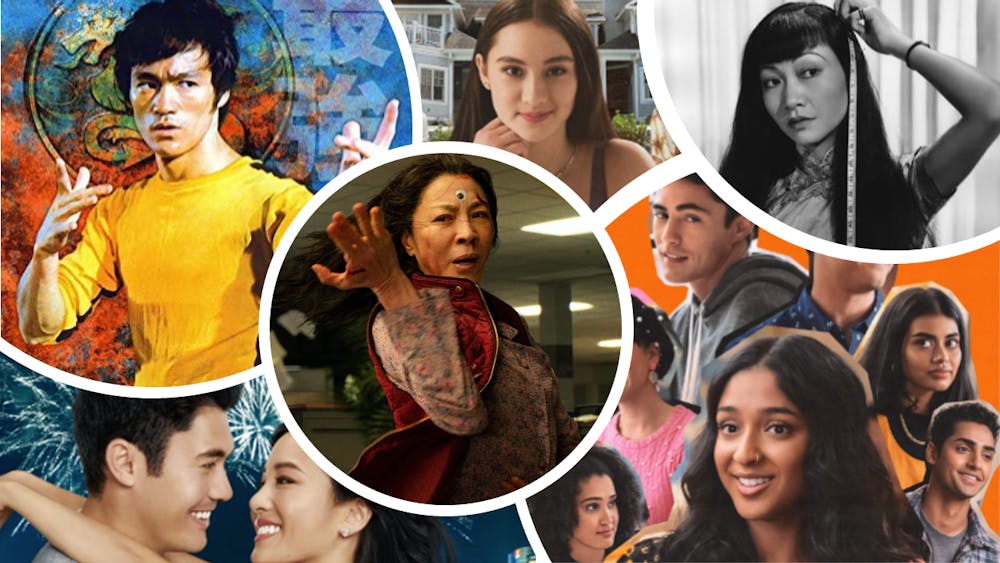The abbreviation AAPI, an acronym for the term “Asian American and Pacific Islander,” has been making its way towards the global stage in familiarity among audiences.
As a minority group in the U.S., the AAPI community has been struggling to establish a solid and fair place within American society for decades since ancestral arrival in the mid 1800s—the media industry has not been an exception.
During the 1960s, when Asians were first cast as leads in Hollywood films, roles mainly revolved around stereotypical labels, such being a “dragon lady” for women, a Western term used to describe an Asian woman who is strong, domineering and sexually alluring. Men were generally displayed as an “immoral gambling addict.”
Moreover, films often contained degrading references which insinuated and encouraged the socially racist implications posed upon the AAPI community.
Asian American actors such as Anna May Wong and Bruce Lee are two prime examples out of the many who were subjected to such prejudiced circumstances.
Wong herself recalled the history of her career mainly revolving around her character always dying in the end. Her most famous role was from the film “Daughter of the Dragon”, where she played a murderer on a mission to kill a Scotland Yard detective.
Whitewashing the cast was also a common problematic issue at this time.
When all-time renowned martial artist and film star, Bruce Lee, entered the industry, there was little opportunity for him to land roles that permitted him to shine authentically. Even amid favorable ideas developed by Lee, directors deemed having a white actor as the lead more profitable and appealing.
Though the film industry has experienced growth in becoming more diverse, there is still room for inclusion and acknowledgement of what really encompasses the true identity of AAPI individuals.
In a summer 2021 study, the portrayal of AAPI communities in the entertainment industry was meticulously analyzed. The study culminated that within films retaining AAPI characters as main cast members, roughly a third of the AAPI characters were depicted through customary stereotypes such as the “martial artist”, the “model minority” or the “exotic women.” Out of the top 10 films from 2010-2019 in the United States, 17% of female AAPI characters were verbally objectified and 13% were visually objectified.
Michi Trota, a five-time Hugo Award winner and features editor at Prism, recalls the visualization of Asians in films she saw while growing up.
“You did see Asian characters in American media, but when you did see them, they were in very background roles, very stereotypical roles,” said Trota who grew up during the 80’s, “the math nerd, the awkward nerd, the dragon lady.”
There isn’t more representation now, but better representation, Trota said.
Trota expressed the importance of recognizing past works that were completed to “soften the ground.”
“I don’t think we would have gotten something like the new ‘Kung Fu’ series if we hadn’t had something like the ‘Vanishing Son’ 20 years ago,” Trota said, “which chips away the belief that you can’t have an Asian male as a lead cast in a show.”
Even so, Trota stresses how vital it is to place equal emphasis on the disparities—such as the number of Asian scriptwriters present—that take place behind the development of films.
“As much as we talk about the on-screen representation, because that’s the easiest thing to see, it’s really important to keep the spotlight on who is making the decisions and putting words in the mouth of those characters,” Trota said.
Historical castings that have either distorted or hidden the identity of the AAPI community, however, have not been enough to halt the growing development of AAPI representation in media. A 2021 Nielson study reported that Asian representation rose to 4.6% in broadcast, cable, and SVOD (subscription video-on demand), compared to its previous year (2020) number of 3.2%.
This growth has also extended to the South Asian community, one of the subgroups within the AAPI community. The first South Asian superhero, Kingo, was introduced in the Marvel Cinematic Universe. Per statistics from Nielson, South Asian men saw an increase in their media representation, with a share of 2.3%. However, there is still room for fairer representation of South Asian women, whose screen share was only 0.3%.
2022’s release of films featuring AAPI main leads beamed hope, reaching the hearts of the old and young in the AAPI community.
The release of “The Summer I Turned Pretty” Amazon series, originally a novel by Jenny Han, received a wave of support for its representation through the casting of Lola Tung–who portrays a Korean American in the series–as the lead character.
As a coming-of-age story, many viewers of the AAPI community felt a sense of pride from how the show contributed to breaking beauty standards otherwise seen in mainstream media.
“Everything Everywhere All at Once” was another major emotional hit for many AAPI viewers. The film centered on a number of realistic dilemmas that immigrant families experience—many of which hit close to home for many in the AAPI community.
But direct on-screen placement is not enough to be classified as even closely sufficient for equitable representation. A multitude of platforms and perspectives will need to be explored in order to provide an accurate portrayal of what truly defines the authentic identity of AAPI communities.
Heaven Xiong is a junior majoring in human resources, management, international studies, and journalism, with a minor in economics. She is a writer and reporter for The Campus Citizen.





